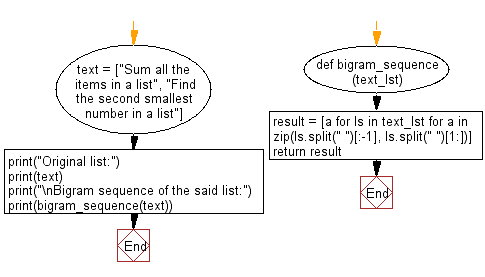Python: Bigrams of words in a given list of strings
Python List: Exercise - 184 with Solution
Write a Python program to form Bigrams of words in a given list of strings.
From Wikipedia:
A bigram or digram is a sequence of two adjacent elements from a string of tokens, which are typically letters, syllables, or words. A bigram is an n-gram for n=2. The frequency distribution of every bigram in a string is commonly used for simple statistical analysis of text in many applications, including in computational linguistics, cryptography, speech recognition, and so on.
Sample Solution:
Python Code:
def bigram_sequence(text_lst):
result = [a for ls in text_lst for a in zip(ls.split(" ")[:-1], ls.split(" ")[1:])]
return result
text = ["Sum all the items in a list", "Find the second smallest number in a list"]
print("Original list:")
print(text)
print("\nBigram sequence of the said list:")
print(bigram_sequence(text))
Sample Output:
Original list:
['Sum all the items in a list', 'Find the second smallest number in a list']
Bigram sequence of the said list:
[('Sum', 'all'), ('all', 'the'), ('the', 'items'), ('items', 'in'), ('in', 'a'), ('a', 'list'), ('Find', 'the'), ('the', 'second'), ('second', 'smallest'), ('smallest', 'number'), ('number', 'in'), ('in', 'a'), ('a', 'list')]
Flowchart:

Visualize Python code execution:
The following tool visualize what the computer is doing step-by-step as it executes the said program:
Python Code Editor:
Have another way to solve this solution? Contribute your code (and comments) through Disqus.
Previous: Write a Python program to get the unique values in a given list of lists.
Next: Write a Python program to convert a given decimal number to binary list.
What is the difficulty level of this exercise?
Test your Programming skills with w3resource's quiz.
Python: Tips of the Day
Find current directory and file's directory:
To get the full path to the directory a Python file is contained in, write this in that file:
import os dir_path = os.path.dirname(os.path.realpath(__file__))
(Note that the incantation above won't work if you've already used os.chdir() to change your current working directory, since the value of the __file__ constant is relative to the current working directory and is not changed by an os.chdir() call.)
To get the current working directory use
import os cwd = os.getcwd()
Documentation references for the modules, constants and functions used above:
- The os and os.path modules.
- The __file__ constant
- os.path.realpath(path) (returns "the canonical path of the specified filename, eliminating any symbolic links encountered in the path")
- os.path.dirname(path) (returns "the directory name of pathname path")
- os.getcwd() (returns "a string representing the current working directory")
- os.chdir(path) ("change the current working directory to path")
Ref: https://bit.ly/3fy0R6m
- New Content published on w3resource:
- HTML-CSS Practical: Exercises, Practice, Solution
- Java Regular Expression: Exercises, Practice, Solution
- Scala Programming Exercises, Practice, Solution
- Python Itertools exercises
- Python Numpy exercises
- Python GeoPy Package exercises
- Python Pandas exercises
- Python nltk exercises
- Python BeautifulSoup exercises
- Form Template
- Composer - PHP Package Manager
- PHPUnit - PHP Testing
- Laravel - PHP Framework
- Angular - JavaScript Framework
- Vue - JavaScript Framework
- Jest - JavaScript Testing Framework
